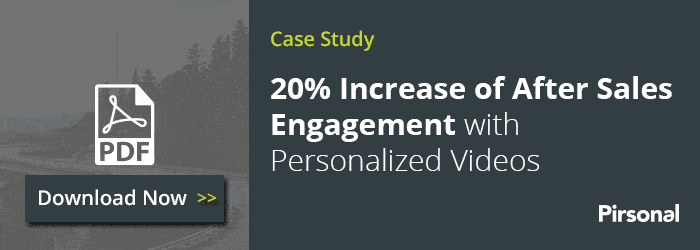Personalized marketing is not a new thing. It’s been there forever. I’m 33 and it was already there when I was born. It was even there when Jesus rose from the dead. But little by little it is not only changing its ways but also how we do business and what kind of ROI we get from our efforts.
One at a time it is also shaping a new army of technologies, platforms, APIs, devices and suites to make it more integrable and affordable, regardless of the size of your company. That’s simply amazing.
Marketing
I remember when word of mouth marketing started been a huge thing. It was already there but, you know, marketers and agencies just started talking a lot about it. I was in college collaborating with an online TV channel focused on easy-to-make food for people without a lot of time to cook.
The startup never got to launch, but we certainly had a blast working on it and it helped me learn more about alternative ways to market a service. Around the same time, I invested about nine months investigating and writing about guerrilla marketing. A never-published book resulted out of that experience.
I guess I just love the way humans can be creative in order to evoke a reaction from the people that surround us. At the beginning, it had to do with how far a story could make it. Then about how visual and easy to remember it was designed. Then it was about the channel, from radio to television to the Internet. Again, little by little it made it about the platform used to share the message and how adapted that message was.
At some point, we started talking about audiences. We needed to. Then we started segmenting our audiences a little bit more. It got complicated. It also got results. When you think about your audience, when you shorten the list, not only to what matters to you but especially to whom that message matters to, it works; it is more effective and, thanks to technology, it can also be scalable.
Until not that long ago, as marketers and business developers, we have spoken a lot about personalization. The thing is that, nowadays, talking about marketing without at least considering personalization simply doesn’t make sense. I’m not saying it needs to be applied to every case but, if you have the opportunity, it surely makes huge a difference.
Personalized Marketing
What’s personalized marketing? To keep it simple, marketing personalization is about leveraging the data we have available about someone — you name it, a customer, a prospect, a lead or your next door neighbor — to connect with them through custom messages and/or offerings.
With the data available out there about all of us, with our consent, the concept is crystal clear. In its early days, personalized marketing was shy. It was mainly about things like [First name] or [Company name] or about being able to select this or that color.
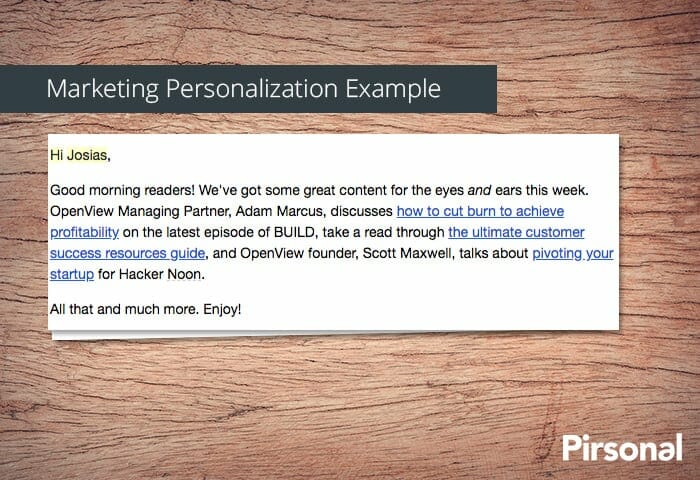
The image shows the most basic personalization in email marketing: personalizing the name.
We all improved our numbers, considerably.
The thing is that we are not in the business of creating cool products or services; I’ve been in that business before. At Pirsonal we are in the business of evoking reactions from segmented people; the reaction you, and as a company, want, need and fight for because it generates more revenue in one or another way.
Sure the things you currently do work. But we can talk later about why the status quo is hurting your business more than you think.
A whitepaper by IDC called “Can Machines be Creative? How Technology is Transforming Marketing Personalization and Relevance” (PDF) brings some light to the subject. They interviewed 459 marketing executives and found out that 34% were applying personalized marketing techniques to a moderate extent. About 32% of them said that they were personalizing their marketing communications to a greater extent. However, only 10% had completely personalized their digital communications.
Personalized marketing has been hard to achieve in a more integrated way, but because it pays back, it’s becoming the top priority for companies.
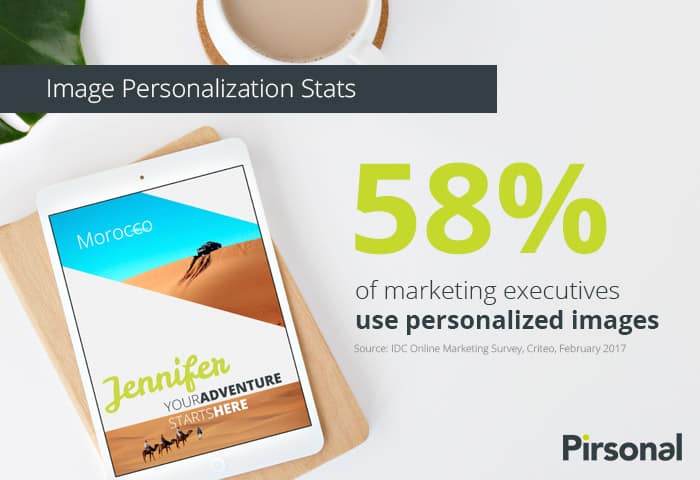
Using personalized images have become the norm for marketers. 29% of them are planning to start personalizing their images soon.
Nowadays, everything can be personalized. This is probably why 58% of marketing executives from the white paper mentioned above were personalizing images in their marketing communications, or why 46% of them were doing the same with calls to action, while 36% were planning to do it.
The thing is that personalized marketing has been in our minds for years, but something we forget about is the other reality. Thanks to today’s technology-driven ecosystem, consumers face an unprecedented and incredible challenge.
Choice.
One of the most obvious choices a consumer has is to, basically, pay attention to whatever a brand is talking about at any given moment. Here is when things like email opening ratio, video engagement ratio or net promoter score are vital.
Why?
Because on the other side of the wall, the one that consumers automatically build based on their choice, your message is waiting for them. This forces companies to do two things: the first one is getting the consumer to actually open the email, for example. The second one is to get the user to actually do as the company expected them to do, for example, to click on a specific button. Two huge challenges.
Something similar happens with display ads or even with cold calling. All of that works, of course, but the challenge is still the same. Creating an appealing door to go through that wall and then inviting the consumer to come in. Obviously, if we are talking about inbound, you may be the one going through the door first.
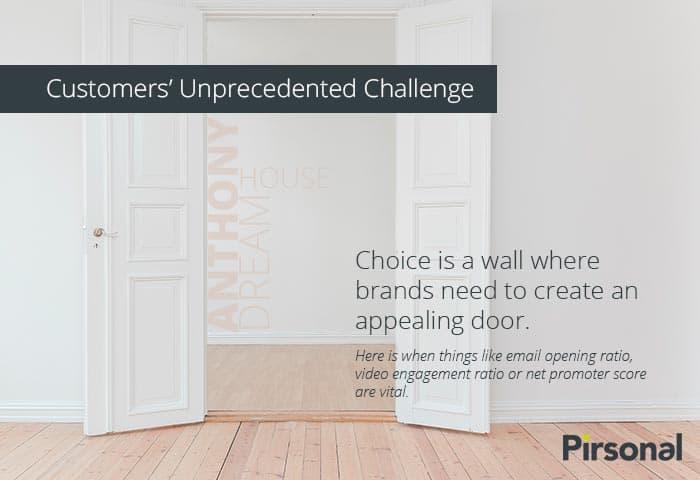
Customers’ choice is one of the main challenges marketers face every day. This is also one of the drivers for personalized marketing strategies.
A more personalized marketing makes that door appealing to the consumer. It helps him realize that whatever you are offering was created with him in mind. To put it simply, this understanding and subsequent action on the leads part translates into higher conversion ratios and more revenue for the company applying the personalization techniques.
Yes, but is it enough? Remember what I mentioned above about the status quo? “Enough” is actually an ugly word in this context. It doesn’t pay back as it should, is not intentional, it gets nowhere in the long term. Just imagine companies like Amazon or Google powered by an “enough” attitude. You can’t.
As a marketer and business developer myself, I’ve seen the power of the extended arm of personalization, because once it’s working, you want more.
Individualized Marketing
Individualized marketing takes place when the individual you want to target, your brand and you as a marketer are aligned. When talking about individualization, everything has to do with a more contextualized marketing.
You take into consideration things like the context, not only the textual data you have access to, but also what that information means, not to you, but to the end-user you are targeting, and how it can be relevant to that individual.
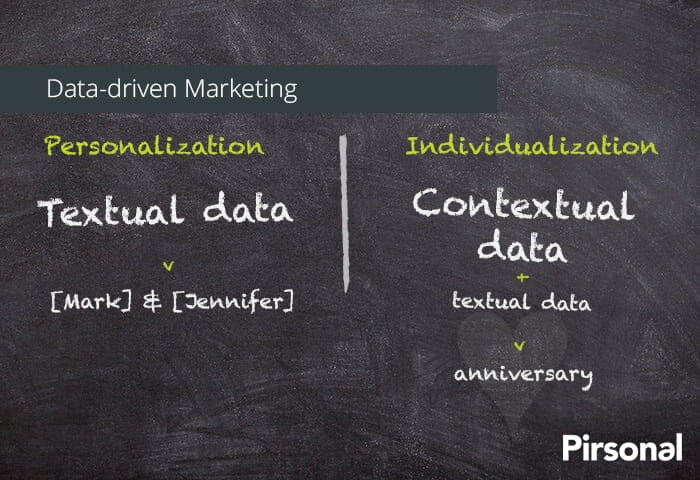
Personalized marketing and individualized marketing
For both, personalized marketing and an individualized one, you can either use Artificial Intelligence or just your creative brain. What matters is that you are able to talk to each individual in a way that makes sense to each one of them, automatically.
When we advise our clients, we make sure that they understand how important it is to take the context into consideration and how translating that context into something that is 100% relevant to their clients is a game-changer. Nowadays, contextualized marketing is not something to not take into consideration; is a must-have.
Why? Because the only thing that matters is getting more. More engaged clients during a longer period of time who are actually buying more from you. And with all the noise out there, the only way to get there is not only by being persistent but especially by contextualizing the right message and delivering that message through the channel that has the highest chance to convert.
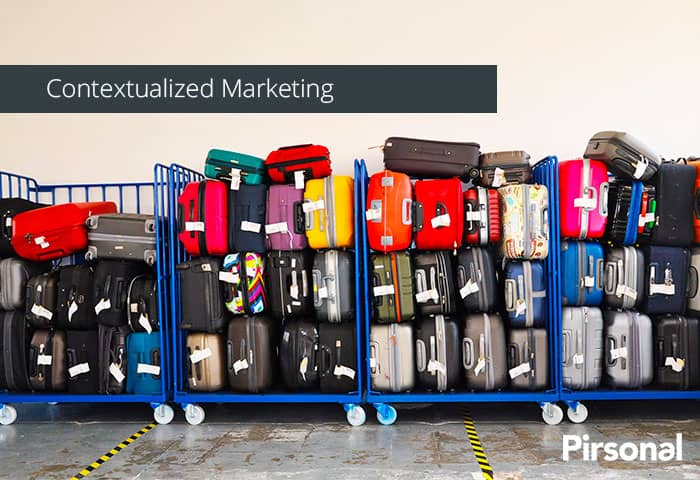
The bridge between personalization and individualization it’s called contextualization.
Have you ever done sales prospecting? It is hard, especially when you have no clue about the person you are talking to. It’s not the same to ask for “the e-commerce manager at Akme” as it is to ask for “John Doe”. That’s the personalization level; it has a higher chance to get you through the door.
Now, when you master prospecting, things change. You do your research, you get a lot of context information and get prepared to different objection scenarios to get through the door, based on what matters (or could matter) to your prospect.
Something similar happens with marketing, personalized marketing and individualized marketing.
Getting through that door is for companies that want more. This is, for companies that create relevant messages, as specific as this can be, to drive a higher engagement, more sales and faster.
And, as Cara Wilson recently noted, it’s not only about what you share but also how you do it. For example, from my experience at Pirsonal, we see our clients going the extra mile and getting a better ROI when the use the channel and approach that better delivers the right message to an individual.
This usually takes place when they combine multimedia individualization powered by videos, images, audios, texts, landing pages and custom call to actions with the one goal to get a reaction from specific people.
A Combined Approach: When Personalized Marketing and Individualization Work Together
Please take a moment to watch the following video:
This personalized video example for a travel agency (and OTA) combines both approaches. On one hand, it uses the textual information provided by a lead (“Mattias and Cristine”); on the other hand, it also uses the contextual information shared by the same lead while talking to a travel agent (“anniversary”).
This is a great way to contextualize the information in an appealing way. It gets the lead excited and pushes him (or them, in this case) to buy… faster.
The end result is a fully customized experience that accelerates the sales process, powered by an individualized video, a dynamic landing page and a personalized interactive player that helps this brand close on the lead faster.
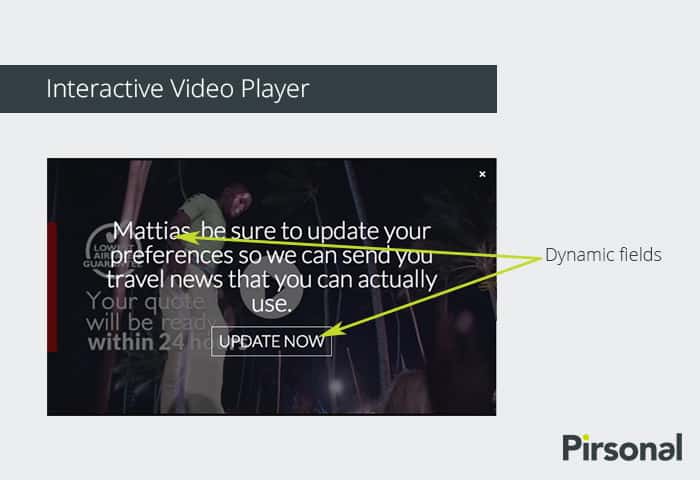
Personalized Interactive Video Player: Call to Action (CTA) Example
If you ever need to work on a personalized video pilot of POC, make sure to follow this checklist that guides you through the 10 steps to successfully create a personalized video program from scratch according to your needs.
How Advertisers’ Priorities Are Aligned With Individualization and Personalization
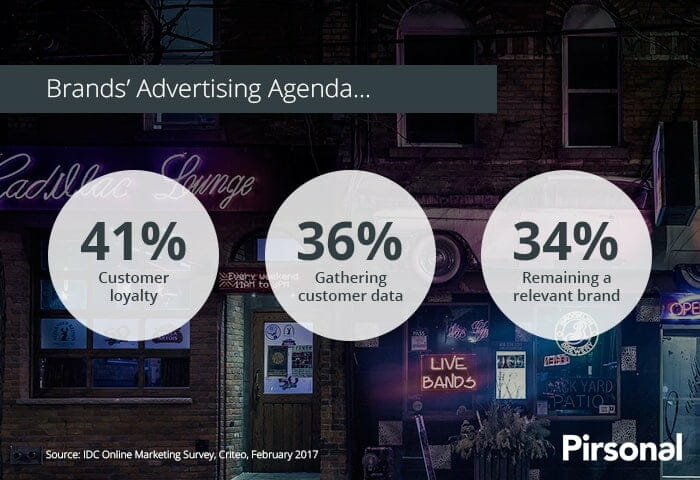
Brands’ Advertising Goals
This is actually aligned with IDC’s study. Customer loyalty is still a top priority for brands (41%). Think about the customer lifetime value. Now imagine an auto brand leasing their vehicles. One of their top priorities is to keep a customer for the longest period of time. In the end, they sell a financial product, so a loyal client is not really “buying a car”, is “buying a house”… Or two.
But buyers change all the time, and this is something to take into consideration when strategizing. For example, in the car industry the repurchase frequency changes based on key factors like the age of the customer (older people keep their cars for longer) or income (higher income translates into earlier repurchase or re-lease).
This is why gathering customer data is extremely important, and using that data smartly is even more urgent. This is how brands become or remain relevant. By contextualizing their offering, messaging and channels to the individual buyer. Gone should be the days when mass audiences were the engine for brands that had something to say.
As “Analysis of automobile repeat-purchase behaviour on CRM” by Juyoung Kim, Myung Suk Kim, (2014) quotes:
Empirical results show that age, price difference, change in vehicle type, and marketing promotion affect the likelihood of repeat purchase. VIP service centres and repair services are effective marketing tools, and dealers should pay more attention to existing customers having certain characteristics, depending on prior purchase behaviour.
A great personalized email example
Take a look at the personalized email example below. It’s a simple yet great personalized email example. It combined both concepts, personalization and individualization. How? The context is key. It combines different types of personalized content: a link to a personalized video, personalized images, personalized texts and more.
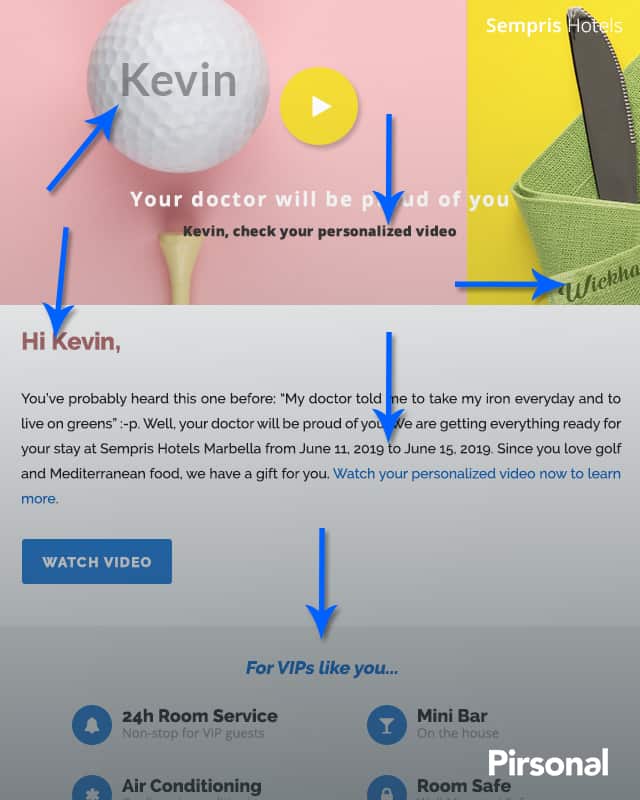
Actually, in the following video, I explain how to create personalized emails for your marketing and sales effort to increase conversions. Feel free to let me know your thoughts:
As you probably noticed, in this example, I used the term “personalization” to also talk about “individualization”. Why? That’s how most people refer to these terms.
Takeaway
As marketers, we need to be more intentional. We can not only stick to what works, we need to go after what over-delivers, with a similar approach to the one salespeople have, but with the right tools, messages, data, workflows and automation to make the processes scalable and relevant to the individual.
A more contextualized marketing has proven to help companies to get there. This is, combining the personalization approach with the context that surrounds every and each individual within our funnel. This might require using machine learning or similar technologies, or something as simple as creativity and a clear structure.
Personalized or individualized marketing? If you ask me, do both whenever you can. Do your best to not only perform but to over-perform.
Have you used any type of personalization and/or individualization for your marketing? Feel free to share your feedback. Let us know what worked and what didn’t work.
